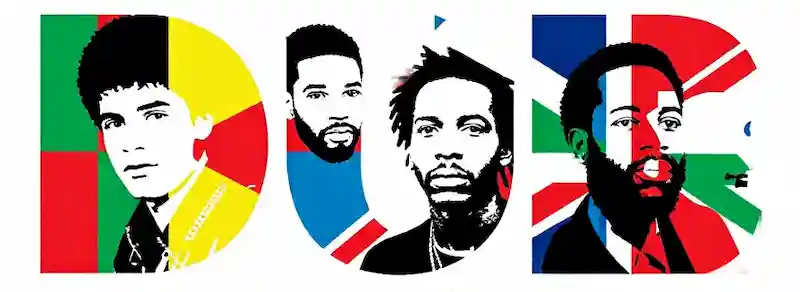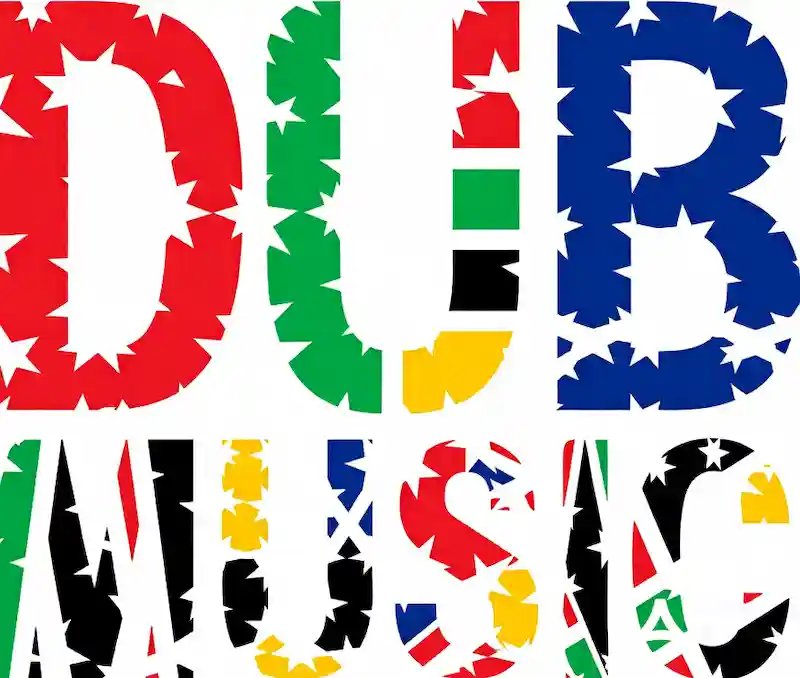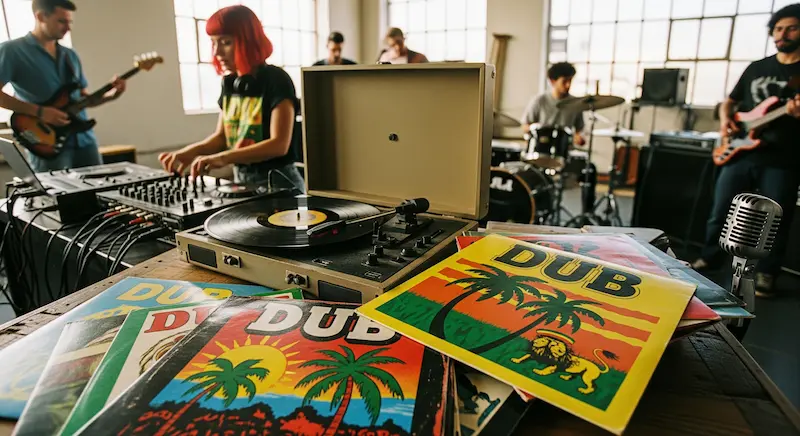
Introduction: What Is Dub Music?
To understand the global soundscape of modern music — from remix culture to electronic beats — you have to start in a small Kingston studio in the late 1960s. This is where Dub music was born. But what is Dub music exactly?
Dub is more than a subgenre of reggae. It’s a revolutionary style of music production that deconstructs tracks to their core, rebuilds them with effects like echo, reverb, and delay, and transforms rhythm into atmosphere. It’s minimalist and psychedelic. It’s cultural and technical. And its influence is far deeper than most casual listeners realize.
This article dives deep into the history of Dub music, exploring its evolution, revolutionary pioneers, ground-breaking techniques, and its vast impact across genres and decades. Welcome to the echo chamber.
The Origins: The Birthplace of Dub
The history of Dub music begins in late 1960s Jamaica, during a time of intense cultural innovation and political tension. Sound systems — mobile DJ collectives with massive speaker stacks — dominated the streets of Kingston. These events weren’t just about partying; they were about identity, resistance, and community.
Jamaican producers began releasing instrumental versions (called “versions”) of popular reggae tracks on the B-sides of vinyl singles. This gave DJs the opportunity to “toast” — adding rhythmic speech or chanting over the stripped-down instrumental.
But it was King Tubby (Osbourne Ruddock), a sound engineer and electrical repairman, who turned these versions into an entirely new art form. Tubby began manipulating the instrumentals using homemade effects, dropping vocals in and out, pushing drum and bass to the front, and using echo, reverb, and delay to create a haunting, otherworldly soundscape. This was the birth of Dub — not just a new genre, but arguably the world’s first true remix culture.

Dub Music Pioneers: The Architects of Echo
Dub didn’t emerge from a single source. While King Tubby was the undisputed innovator, a group of brilliant minds contributed to the evolution of Dub music and helped it spread beyond Jamaica.
🔊 King Tubby Tubby’s workshop in Kingston became ground zero for Dub. His mixing board was an instrument. He isolated elements of a track, adding space and tension. His invention created a vivid auditory experience out of passive listening.
🔥 Lee “Scratch” Perry Known for his eccentric genius, Lee “Scratch” Perry brought a wild, psychedelic flavor to Dub. Using unconventional methods to enhance depth and mystique, such as blowing Ganja smoke across cassettes and burying microphones in soil, Perry worked out of his Black Ark Studio. He worked closely with Bob Marley & The Wailers and produced some of the deepest Dub cuts of the era.
🎧 Scientist, a King Tubby protégé, gave Dub a more youthful, futuristic edge. His “meets the space invaders” series expanded Dub’s reach into sci-fi themes and electronic experimentation.
🎛️ Errol Thompson and Joe Gibbs This duo produced classic Dub albums that fused studio discipline with wild experimentation. Their series, African Dub All-Mighty, remains a cornerstone of the genre. These Dub music pioneers laid the foundation for modern remixing, sampling, and electronic manipulation. Today, their influence can be heard in almost every aspect of music.
Dub Music Techniques: The Sound of Space

What separates Dub from other reggae subgenres isn’t melody or lyrics — it’s technique. The Dub producer (or “engineer”) becomes the artist, sculpting existing material into a new creation.
Key Dub Techniques:
- Echo: A repeating delay that creates rhythmic feedback. Often layered to surreal effect.
- Reverb: Simulates spatial depth — like vocals bouncing in a cathedral.
- Dropouts: Entire elements (e.g., vocals, drums, guitar) are cut mid-track, creating tension and surprise.
- Filtering & Phasing: Alters frequencies for psychedelic swirls and textures.
- Tape Manipulation: Speeding up or slowing down tape for pitch shifts or warped sound. These tools were often used on analog equipment — meaning every Dub mix was unique. Today, digital plugins emulate these effects, but the soul of Dub lies in manual spontaneity and sonic risk-taking.
The Evolution of Dub Music
Initially just B-sides for toasters, Dub music quickly grew into a form all its own. By the mid-1970s, Dub had become a recognized genre, with its own stars, albums, and followers.
📀 1970s: Roots and Studio Experimentation
Classic albums from its pioneering era, such as pivotal works by King Tubby and Lee ‘Scratch’ Perry, elevated Dub into a full artistic expression. Dub combined technological prowess with spiritual themes, frequently referencing Afro-futurism, social resistance, and Rastafarian mysticism.
🌍 1980s: Global Spread
Jamaican immigrants introduced Dub to UK places such as Bristol and London. Dub merged with post-punk and various electronic music forms, inspiring bands like The Clash, Public Image Ltd, and New Order.
💻 1990s–2000s: Digital Dub and Genre Hybrids
Digital tools lowered the barrier to entry, leading to a boom in DIY Dub producers. Dub fused with techno, house, drum & bass, and ambient, giving rise to dub techno, dubstep, and trip-hop.
🌐 Today: Legacy and Revival
Artists like Zion Train, Mad Professor, O.B.F, and Dub FX keep the flame alive. Dub is central to reggae festivals, sound system culture, and bass music events worldwide.
Dub Reggae: Where Dub and Roots Intersect
While all Dub music originated from reggae, not all reggae is Dub. Dub reggae specifically refers to instrumental or remixed versions of reggae songs with studio effects. Bob Marley’s classic tracks — especially under Lee Perry’s influence — had Dub versions released alongside them. Lee Perry’s backing band, The Upsetters, often recorded full Dub albums that allowed listeners to experience the spirit of the song without the lyrics — where the beat, the space, and the vibe speak louder. Dub reggae is particularly popular with:
- Dance culture, where heavy bass and minimalism create a trance-like rhythm
- Sound system DJs, who toast or sing over riddims
- Rastafarians, for whom the spacious quality feels meditative

The Influence of Dub Music
The impact of Dub music is profound. It doesn’t just live in reggae or niche music circles — it underpins nearly everything in modern audio production.
🔊 1. Remix Culture
Dub was the first genre to remix existing tracks — creating entirely new versions from old material. This directly inspired hip-hop (especially in Bronx DJ culture), dancehall, and the entire DJ movement.
🎧 2. Sampling & Looping
Dub introduced the idea of isolating instrumental elements and repeating them — a technique now central to sampling in hip-hop, trap, and EDM.
🎧 3. Electronic Music Genres
Dub directly inspired:
- Dubstep (named after it!)
- Drum and Bass
- Trip-Hop (Massive Attack, Tricky, Portishead)
- Dub Techno (Basic Channel, Rhythm & Sound)
🎼 4. Post-Punk & Rock
UK punk bands like The Clash adopted Dub basslines and studio effects into their songwriting. The influence can also be heard in Radiohead, Gorillaz, and even Nine Inch Nails.
🌍 5. Global Bass and Sound System Culture
From Berlin to São Paulo, Dub’s bass-heavy philosophy has shaped club culture, street sound systems, and experimental electronic festivals.

Dub Music and Sound System Culture
If reggae is Jamaica’s pulse, then sound system culture is its thunder. Long before Dub filled headphones and playlists, it was shaking the ground in Kingston through giant speaker stacks, mobile discos, and late-night clashes. This is where Dub music came to life, not in silence, but on the dancefloor — raw, loud, and communal.
A sound system was more than equipment. It was a crew — typically including a selector (DJ), operator (sound engineer), toaster (MC), and support crew. These mobile outfits would roll into neighborhoods, plug into power lines, and transform street corners into pulsing block parties.
Dub music was a secret weapon in this world. Producers and engineers would craft special mixes with dramatic dropouts, thunderous basslines, and surreal echo trails — designed to captivate dancers and outshine rival crews.
The power of Dub wasn’t just technical — it was theatrical. In many ways, Dub was the first live remix performance art — with sound system operators manually manipulating the music in real time. That legacy lives on today in DJ culture, EDM, and hip-hop.
Dub and Political Consciousness
While Dub is famous for its sonic experimentation, its spirit has always been deeply political. At its core, Dub is a sound of resistance — against colonialism, oppression, and spiritual decay.
A large portion of Dub came into being in the 1970s, when Jamaica was experiencing severe political upheaval.
As tensions between conservative and socialist parties spilled into violence, reggae artists began using music to voice discontent, promote unity, and call for revolution. Dub offered a powerful way to amplify — or subvert — those messages.
The technique of dropping out vocals or isolating a single line wasn’t just artistic — it was symbolic. Silence in Dub often represented censorship, disruption, or spiritual space.
Meanwhile, artists like Burning Spear, Mikey Dread, and Augustus Pablo infused their Dub tracks with heavy spiritual overtones, invoking themes of exile, struggle, and redemption.
Dub’s use of empty space is more than a studio trick — it’s a political statement. In a world filled with noise and distraction, Dub creates room to think, feel, and resist.

Modern Digital Dub Scenes Around the World
Far from fading, Dub music continues to evolve — thriving in a global underground that spans continents and generations. While its heart still beats in Jamaica, today’s Dub has many homes, many accents, and many innovations.
🌍 Europe
Europe has become a major hub for modern Dub revival. France’s O.B.F Sound System brings heavyweight bass and militant vibes to festivals like Dub Camp and Telerama Dub. In the UK, veterans like Mad Professor, Jah Shaka, and Mungo’s Hi Fi keep the tradition alive while pushing sonic boundaries.
🌊 Australasia
In New Zealand and Australia, Dub found fertile ground in Pacific reggae culture. Bands like Fat Freddy’s Drop, Katchafire, and Salmonella Dub mix Dub with soul, jazz, and funk to create a warm, organic vibe.
📍 South America & Africa
Dub has taken root in Latin America and Africa, blending with cumbia, Afrobeat, and local rhythms. In Brazil, Dub meets samba in cities like São Paulo. In East Africa, reggae-Dub hybrids amplify youth voices in Nairobi and Kampala.

Top Dub Albums That Defined the Genre
- King Tubby Meets the Rockers Uptown – Augustus Pablo (1976)
- A seminal Dub album that combines Tubby’s flawless mixing with Pablo’s eerie melodica. Sparse, spiritual, and hypnotic.
- Super Ape – Lee “Scratch” Perry & The Upsetters (1976)
- A psychedelic journey through the mind of Perry. Layers of effects, animalistic sounds, and studio magic make it a Dub masterpiece.
- Scientist Rids the World of the Evil Curse of the Vampires (1981)
- Bold, cinematic, and futuristic — Scientist created a sci-fi Dub world with punchy drums and eerie effects.
- African Dub All-Mighty Series – Joe Gibbs & The Professionals (1970s)
- This influential series fused tight musicianship with classic studio techniques — soulful yet militant.
- Dub Side of the Moon – Easy Star All-Stars (2003)
- A full Dub reinterpretation of Pink Floyd’s classic album. A modern tribute to Dub’s legacy of remixing.
- No Protection – Mad Professor vs Massive Attack (1995)
- A landmark crossover, transforming trip-hop into a brooding, sensual experience.
- Rhythm & Sound – Rhythm & Sound (2001)
- A deep, minimalist, techno-infused approach to Dub from Berlin. Essential for fans of dub techno.

Conclusion: Echoes That Never Fade
The history of Dub music is an unparalleled journey of radical innovation, spiritual depth, and profound global impact.
From King Tubby’s dusty console to your modern playlist, Dub’s fingerprint is everywhere. Whether you’re meditating to reverb-drenched riddims, dancing to dubstep, or remixing your own beats, you’re part of a legacy that started in a Kingston echo chamber.
So next time the bass drops and space opens in a track — thank Dub.

